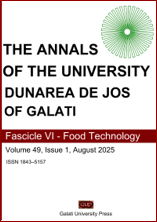A novel approach to craft jelly candies with quince and sea buckthorn: quality and bioactive insights
Abstract
This study developed craft jelly candies using quince (Cydonia oblonga) puree and sea buckthorn (Hippophae rhamnoides) dried pomace, emphasizing by-product valorization. Five candy formulations with varying levels of sea buckthorn pomace powder (0%, 1%, 2%, 3%, and 4%) were evaluated for nutritional composition, sensory attributes, and physicochemical properties. The incorporation of sea buckthorn powder enhanced the antioxidant content of the candies. DPPH radical scavenging activity increased, reaching 91.71%, while hydrogen peroxide scavenging capacity improved to 26.67%. The fiber content varied between 7.19% and 6.61%, slightly decreasing due to the higher dilution effect from added water and honey. Total polyphenol content ranged from 633.28 mg GAE/100 g in samples with quince puree to 597.21 mg GAE/100 g in the highest sea buckthorn formulation. Formulations with 1% and 2% sea buckthorn powder achieved a well-balanced texture, taste, and appearance, whereas higher levels resulted in excessive tartness and textural changes. Sensory evaluation using the Check-All-That-Apply (CATA) method linked moderate sea buckthorn incorporation with high acceptability. The utilization of quince puree and sea buckthorn pomace in confectionery production enhanced nutritional value, contributing to sustainable food development and reducing agricultural waste.


